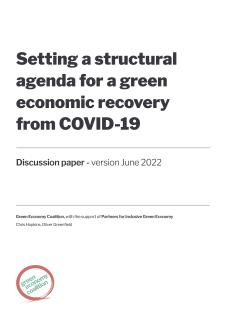
In response to COVID-19, new thinking around how to plan, implement and manage a green recovery has emerged.
This paper provides an outline of this aspirational structural green recovery agenda, and gives a tentative mapping of the prioritization criteria governments might consider in designing structural reform packages. In addition, it considers gaps and weak links in the green structural reform agenda as currently conceived, surveys the barriers blocking adequate structural financing, and gives examples of green structural policies that have been deployed at a national level.
It offers a number of key recommendations for policymakers, including the need to strengthen the emerging framework of green structural reform measures to create a coherent superstructure for national-level action on green recovery beyond the current phase, and to strengthen joint planning processes to promote dialogue with key national actors and enhance institutional capacity to achieve green and inclusive recovery.
